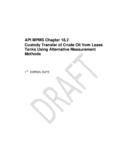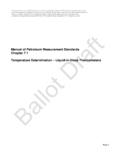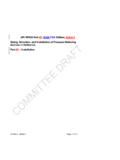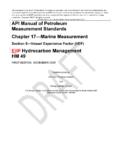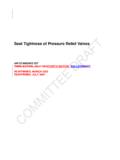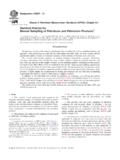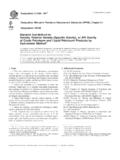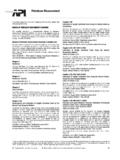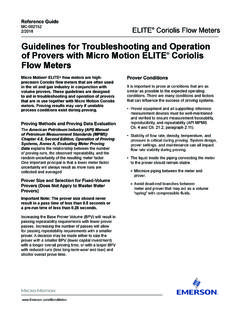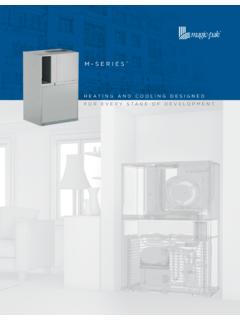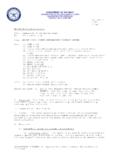Transcription of API MPMS Chapter 11.3.3, Miscellaneous …
1 API mpms Chapter , Miscellaneous hydrocarbon product properties denatured Ethanol Density and Volume Correction Factors Proposed changes to the 2nd edition, this would become the 3rd edition: Rationale for Ballot: A new Annex E is proposed to be added to API mpms Chapter The addition of Annex E is needed to address the custody transfer of fuel ethanol at elevated pressures. The research work that went into development of was limited to 50 psig pressures and the pressure effect on the density was not consider significant during the initial development of Further discussions with users of the standard have indicated that there is an industry need for correction of fuel ethanol volumes at elevated pressures. The inclusion of Annex E allows volume of fuel ethanol at elevated pressures to be corrected in a manner that is consistent with other API mpms standards.
2 Because of the addition of Annex E, it was necessary for clarification to add new wording to Sections 3, , Also, a new Section was added to explain the pressure correction for Fuel Ethanol and point to Annex E. Below are the proposed modifications to the body of API mpms Chapter The proposed new Annex E follows those proposed modifications. The remainder of the document is NOT open for ballot. Please vote and comment only on the proposed changes below. The following sections are proposed to be modified in mpms Section 3 Terms and Definitions The following terms and definitions are proposed to be added and are part of this revision Correction for the effect of Temperature on Liquid (CTL). Compensates for the effect of temperature on a liquid.
3 Correction for the effect of Pressure on Liquid (CPL). Compensates for the effect of pressure on a liquid. Correction for Temperature and Pressure of a Liquid (CTPL). Corrects a volume at an observed temperature and pressure to an equivalent volume at a reference temperature and pressure and is equal to CTL CPL. This combination of factors is also often referred to as a VCF. Section denatured 99+% Fuel Ethanol The following sentences are proposed to be added at the end of the first paragraph of Section If the observed conditions are at elevated pressure, then a CPL for the liquid should be calculated according to the procedures outlined in Annex E and a combined CTPL should be applied to correct the observed density or volume to 60 F and standard atmospheric pressure.
4 The first paragraph therefore becomes: For volume or density correction from observed temperature to 60 F, the implementation procedure given in API mpms Ch. shall be used for denatured 99 % fuel ethanol. denatured 99+ % fuel ethanol is considered to be a special application (formerly known as Table 6C or Table 54C) with an alpha coefficient of F or C (Annex A). If the observed conditions are at elevated pressure, then a CPL for the liquid should be calculated according to the procedures outlined in Annex E. and a combined CTPL should be applied to correct the observed density or volume to 60 F and standard atmospheric pressure Section denatured 95 % to 99 % Fuel Ethanol The following sentence are proposed to be added at the end of the first paragraph of Section If the observed conditions are at elevated pressure, then a CPL for the liquid should be calculated according to the procedures outlined in Annex E and a combined CTPL should be applied to correct the observed density or volume to 60 F and standard atmospheric pressure.
5 The first paragraph becomes: For volume or density correction from observed temperature to 60 F, the implementation procedure given in API mpms Ch. shall be used for ethanol denatured with 1 % to 5 % by volume of either natural gasoline or gasoline (Annex B). Such denatured ethanol is considered to be a special application (formerly known as Table 6C or Table 54C) with an alpha coefficient of F or C (Annex C). For more information on denaturant choice, see Annex B. For more information on the applicability of these alpha coefficients to other denaturants, see Annex C and Annex D. If the observed conditions are at elevated pressure, then a CPL for the liquid should be calculated according to the procedures outlined in Annex E and a combined CTPL should be applied to correct the observed density or volume to 60 F and standard atmospheric pressure.
6 The following section is proposed as a new section to be added to mpms Pressure Correction of Fuel Ethanol For volume correction of fuel ethanol being transferred at elevated pressures, the compressibility of the fuel ethanol should be considered. The experimental program for development of the temperature correction factors did not account for elevated pressures, so no independent data for fuel ethanol exist to demonstrate the differences between fuel ethanol and reagent grade at the denaturant concentrations considered by this standard. Annex E was developed based upon reagent grade ethanol and should be used for applications where pressure corrections are applied. Annex E provides calculation methods for determining the pressure correction factor, CPL, for fuel ethanol.
7 Sections and provide methods for determining the temperature correction factor, CTL, for fuel ethanol. Taken together the overall volume correction factor, VCF, or correction for temperature and pressure, CTPL is the product of CTL x CPL. Proposed mpms Chapter Annex E. Abstract The secant compressibility of ethanol has been correlated over the range of -40 to 60 C (-40 to 140 F) over the pressure range of 0 to 15 MPa (0 to 2200 psi) to a correlation form suitable for correction of pressurized liquid ethanol streams to saturation conditions. Keywords: ethanol; compressibility When ethanol is metered at elevated pressures, it is necessary to account for the difference between the density of ethanol at the elevated pressure and standard reference pressures.
8 The isothermal compressibility of pure ethanol at elevated pressures has been determined by many experimentalist and several equations of state have been proposed. Sun and coworkers (Sun, Schouten, Kortbeek, & Biswas, 1990) found that a third-degree Davis-Gordon expansion fit experimental data best over a range of 0 to 280 MPa. An equation of state for thermodynamic properties of ethanol was developed by Dillon and Penocello (Dillon & Penocello, 2003) which agreed with the compressibilities found by Sun and co- workers. Equations of State for Ethanol Sun, et al. proposed two different equations of state for liquid ethanol to cover the ranges of 193 to 263. K (1991) and 273 to 333 K (1990) for pressure up to 280 MPa. However, these pressure explicit equations of state are not particularly useful for most fuel ethanol applications which were developed to follow the API mpms Chapter methodology (2004).
9 The current methodology used in API mpms . Chapter (2004) is based upon the pressure correction in the historical standard, API mpms Chapter (American Petroleum Institute, 1984) which expresses the pressure dependence of the density by the equation form: ( , ) 1. = =. ( , 0 ) [1 ( 0 )]. Where CPL Correction for effect of Pressure on the Liquid (t,P) density at measured conditions (temperature and pressure). (t,P 0 ) saturation density at measured temperature P measured pressure P0 saturation pressure at measured temperature F secant isothermal compressibility This equation form and it relationship to CTL and CTPL are more thoroughly discussed in section of API mpms Chapter (2004). The hydrocarbon correlation for F in API mpms Chapter (2004) is valid for temperatures between -30 to 90 C (-20 to 200 F) and 0 to MPa gauge (0 to 1500 psig), so a similar range of application was selected for development of this standard.
10 Ethanol Correlation The calculated density of ethanol using the equations of state developed by Sun (1991) (1990). was used to calculate the secant compressibility of pure ethanol from -40 to 60 C and 0 to 15 MPa over-pressure. The secant compressibility of ethanol over this range is well represented by the correlation = 0 + 1 + 2 2. Where Fs scaled compressibility factor, F x 106 (SI) or F x 105 (US Customary). t temperature in C (SI) or F (US Customary). Variable SI Units US Customary Units Fp 106/MPa 105/psi T C F. A0 A1 A2 This correlation fit the reported density data within and yielded a 1 relative uncertainty for F s of Example E-1 (US Customary Units). The density of ethanol at 725 psig and 86 F is required. The density of ethanol at 86 F and saturation pressure is lb/gal.
